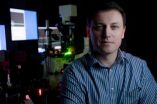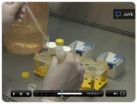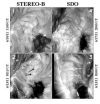(Press-News.org) HOUSTON -- (April 9, 2012) -- Using light-harvesting nanoparticles to convert laser energy into "plasmonic nanobubbles," researchers at Rice University, the University of Texas MD Anderson Cancer Center and Baylor College of Medicine (BCM) are developing new methods to inject drugs and genetic payloads directly into cancer cells. In tests on drug-resistant cancer cells, the researchers found that delivering chemotherapy drugs with nanobubbles was up to 30 times more deadly to cancer cells than traditional drug treatment and required less than one-tenth the clinical dose.
"We are delivering cancer drugs or other genetic cargo at the single-cell level," said Rice's Dmitri Lapotko, a biologist and physicist whose plasmonic nanobubble technique is the subject of four new peer-reviewed studies, including one due later this month in the journal Biomaterials and another published April 3 in the journal PLoS ONE. "By avoiding healthy cells and delivering the drugs directly inside cancer cells, we can simultaneously increase drug efficacy while lowering the dosage."
Delivering drugs and therapies selectively so they affect cancer cells but not healthy cells nearby is a major obstacle in drug delivery. Sorting cancer cells from healthy cells has been successful, but it is both time-consuming and expensive. Researchers have also used nanoparticles to target cancer cells, but nanoparticles can be taken up by healthy cells, so attaching drugs to the nanoparticles can also kill healthy cells.
Rice's nanobubbles are not nanoparticles; rather, they are short-lived events. The nanobubbles are tiny pockets of air and water vapor that are created when laser light strikes a cluster of nanoparticles and is converted instantly into heat. The bubbles form just below the surface of cancer cells. As the bubbles expand and burst, they briefly open small holes in the surface of the cells and allow cancer drugs to rush inside. The same technique can be used to deliver gene therapies and other therapeutic payloads directly into cells.
This method, which has yet to be tested in animals, will require more research before it might be ready for human testing, said Lapotko, faculty fellow in biochemistry and cell biology and in physics and astronomy at Rice.
The Biomaterials study due later this month reports selective genetic modification of human T-cells for the purpose of anti-cancer cell therapy. The paper, which is co-authored by Dr. Malcolm Brenner, professor of medicine and of pediatrics at BCM and director of BCM's Center for Cell and Gene Therapy, found that the method "has the potential to revolutionize drug delivery and gene therapy in diverse applications."
"The nanobubble injection mechanism is an entirely new approach for drug and gene delivery," Brenner said. "It holds great promise for selectively targeting cancer cells that are mixed with healthy cells in the same culture."
Lapotko's plasmonic nanobubbles are generated when a pulse of laser light strikes a plasmon, a wave of electrons that sloshes back and forth across the surface of a metal nanoparticle. By matching the wavelength of the laser to that of the plasmon, and dialing in just the right amount of laser energy, Lapotko's team can ensure that nanobubbles form only around clusters of nanoparticles in cancer cells.
Using the technique to get drugs through a cancer cell's protective outer wall, or cell membrane, can dramatically improve the drug's ability to kill the cancer cell, as shown by Lapotko and MD Anderson's Xiangwei Wu in two recent studies, one in Biomaterials in February and another in Advanced Materials in March.
"Overcoming drug resistance represents one of the major challenges in cancer treatment," said Wu. "Targeting plasmonic nanobubbles to cancer cells has the potential to enhance drug delivery and cancer-cell killing."
To form the nanobubbles, the researchers must first get the gold nanoclusters inside the cancer cells. The scientists do this by tagging individual gold nanoparticles with an antibody that binds to the surface of the cancer cell. Cells ingest the gold nanoparticles and sequester them together in tiny pockets just below their surfaces.
While a few gold nanoparticles are taken up by healthy cells, the cancer cells take up far more, and the selectivity of the procedure owes to the fact that the minimum threshold of laser energy needed to form a nanobubble in a cancer cell is too low to form a nanobubble in a healthy cell.
The research is funded by the National Institutes of Health and is described in the following recent papers:
"Cell-specific transmembrane injection of molecular cargo with gold nanoparticle-generated transient plasmonic nanobubbles," which is due for publication later this month in Biomaterials. Co-authors include Lapotko, Ekaterina Lukianova-Hleb and Daniel Wagner, all of Rice, and BCM's Brenner.
"Plasmonic nanobubble-enhanced endosomal escape processes for selective and guided intracellular delivery of chemotherapy to drug-resistant cancer cells," which appeared in the February issue of Biomaterials. Co-authors include Lapotko, Lukianova-Hleb, Andrey Belyanin and Shruti Kashinath, all of Rice, and MD Anderson's Wu.
"Plasmonic nanobubbles enhance efficacy and selectivity of chemotherapy against drug-resistant cancer cells," which was published online March 7 in the journal Advanced Materials. Co-authors include Lapotko and Lukianova-Hleb, both of Rice; Wu and Ren, both of MD Anderson; and Joseph Zasadzinski of the University of Minnesota.
"Improved cellular specificity of plasmonic nanobubbles versus nanoparticles in heterogeneous cell systems," which was published online April 3 in PLoS ONE. Co-authors include Laptoko, Wagner, Lukianova-Hleb, Daniel Carson, Cindy Farach-Carson, Pamela Constantinou, Brian Danysh and Derek Shenefelt, all of Rice; Wu and Xiaoyang Ren, both of MD Anderson; and Vladimir Kulchitsky of the National Academy of Science of Belarus.
INFORMATION:
VIDEO is available at:
http://www.youtube.com/watch?v=5ImLfi1Wi5s
A high-resolution image is available for download at:
http://news.rice.edu/wp-content/uploads/2012/04/0406_NANOBUBBLES-1.jpg
CAPTION: Dmitri Lapotko
CREDIT: Jeff Fitlow/Rice University
'Nanobubbles' plus chemotherapy equals single-cell cancer targeting
Rice teams with MD Anderson, Baylor College of Medicine to explore drug and gene delivery
2012-04-10
ELSE PRESS RELEASES FROM THIS DATE:
Researchers identify genes that may help in ovarian cancer diagnosis and prognosis
2012-04-10
Philadelphia, PA, April 9, 2012 – Scientists from Duke University Medical Center have determined that genes acting as molecular "on/off" switches can define clinically relevant molecular subtypes of ovarian cancer, providing ideal potential targets for use in clinical prognostic and diagnostic testing. These bimodal genes can define tumor subtypes that have different overall prognoses and respond to different therapeutic regimens. The researchers' results are published in the May issue of The Journal of Molecular Diagnostics.
"We identified a very small set of genes ...
A better tool to diagnose tuberculosis
2012-04-10
Up to 30% of the world's population is infected with Tuberculosis (TB), but in many areas of the world, TB diagnosis still relies on insensitive, poorly standardized, and time-consuming methods. A new diagnostic tool, endorsed by the World Health Organization (WHO), may change that. Dr. Thomas Bodmer shows how it's done in the Journal of Visualized Experiments (JoVE).
Currently, TB is diagnosed through either a skin test, which produces a small bump on the patient's arm when administered and needs to be checked after 72 hours, and through smear microscopy, a method that ...
WirelessTimeClock.com Launches Redesigned Site
2012-04-10
WirelessTimeClock.com, a trusted source for web-based time clocks, has re-launched its website (http://www.wirelesstimeclock.com) with a more intuitive and streamlined design, promising a more enriching experience for businesses searching for reliable employee time clocks and time and attendance management solutions.
"Our customers have been asking for a more intuitive, resourceful site," says Scott Tobin, owner of WirelessTimeClock.com. "We wanted to make sure they could find exactly the clocks and monthly plans that would fit their business needs."
With ...
High-resolution atomic imaging of specimens in liquid by TEM using graphene liquid cell
2012-04-10
Daejeon, the Republic of Korea, April 9, 2012—The Korea Advanced Institute of Science and Technology (KAIST) announced that a research team from the Department of Materials Science and Engineering has developed a technology that enables scientists and engineers to observe processes occurring in liquid media on the smallest possible scale which is less than a nanometer.
Professor Jeong Yong Lee and Researcher Jong Min Yuk, in collaboration with Professor Paul Alivisatos's and Professor Alex Zettl's groups at the University of California, Berkeley, succeeded in making ...
Normalizing tumor blood vessels improves delivery of only the smallest nanomedicines
2012-04-10
Combining two strategies designed to improve the results of cancer treatment – antiangiogenesis drugs and nanomedicines – may only be successful if the smallest nanomedicines are used. A new study from Massachusetts General Hospital (MGH) researchers, appearing in Nature Nanotechnology, finds that normalizing blood vessels within tumors, which improves the delivery of standard chemotherapy drugs, can block the delivery of larger nanotherapy molecules.
"We found that vascular normalization only increases the delivery of the smallest nanomedicines to cancer cells," says ...
SDO and STEREO spot something new on the sun
2012-04-10
One day in the fall of 2011, Neil Sheeley, a solar scientist at the Naval Research Laboratory in Washington, D.C., did what he always does – look through the daily images of the sun from NASA's Solar Dynamics Observatory (SDO).
But on this day he saw something he'd never noticed before: a pattern of cells with bright centers and dark boundaries occurring in the sun's atmosphere, the corona. These cells looked somewhat like a cell pattern that occurs on the sun's surface -- similar to the bubbles that rise to the top of boiling water -- but it was a surprise to find this ...
Atlanta Hardwood Flooring Can Be "Baby-Proof" If Done By FlooringAtlantaNow.com
2012-04-10
It shouldn't be surprising to those who have children, that Atlanta Hardwood Flooring is constantly in harm's way from rambunctious babies! The experts at FlooringAtlantaNow are truly masters of the trade, and most recommend using more durable types of wood for high-traffic areas of your home which are prone to scratches or abrasions.
Most Atlanta Flooring specialists agree that winter is the best time to do these types of installations and upgrades to your home. Because metro-Atlanta is known for its mild winters, the season offers a perfect climate which tends to be ...
Black flies may have a purpose after all
2012-04-10
Athens, Ga. – Black flies drink blood and spread disease such as river blindness—creating misery with their presence. A University of Georgia study, however, proves that the pesky insects can be useful.
Don Champagne, an entomology professor with the UGA College of Agricultural and Environmental Sciences, discovered a way to use the black fly's blood-sucking tactics for medical advancement. The results of his research were published in the journal PLoS One.
"In order to feed on blood, these insects have to contend with our natural defense agents against blood loss—like ...
Sexual reproduction brings long-term benefits, study shows
2012-04-10
Courtship rituals can be all-consuming, demanding time and effort – but now scientists have discovered why it might be worth it.
Attracting a mate – which can take significant effort, such as in a peacock's show of feathers or the exhaustive rutting of stags – can produce benefits for a species in the long term, a study suggests.
Scientists have shown that animals and plants which reproduce sexually are at a considerable advantage to those species – such as some insects and reptiles – that reproduce without a partner.
Researchers at the University of Edinburgh studied ...
Genetic regulator of fat metabolism and muscle fitness discovered
2012-04-10
While exercise is accepted universally as the most beneficial prescription physicians can write for patients, little is known about the molecular mechanisms that generate its widespread health benefits. Researchers from Case Western Reserve School of Medicine have shed light on this mystery by discovering that a genetic factor, Kruppel-like Factor 15 (KLF15), governs the body's ability to burn fat during exercise.
Previous research from the laboratory of Mukesh Jain, MD, FAHA, identified the importance of KLF15 in the metabolism of two of the three basic nutrients used ...
LAST 30 PRESS RELEASES:
Numbers in our sights affect how we perceive space
SIMJ announces global collaborative book project in commemoration of its 75th anniversary
Air pollution exposure and birth weight
Obstructive sleep apnea risk and mental health conditions among older adults
How talking slows eye movements behind the wheel
The Ceramic Society of Japan’s Oxoate Ceramics Research Association launches new international book project
Heart-brain connection: international study reveals the role of the vagus nerve in keeping the heart young
Researchers identify Rb1 as a predictive biomarker for a new therapeutic strategy in some breast cancers
Survey reveals ethical gaps slowing AI adoption in pediatric surgery
Stimulant ADHD medications work differently than thought
AI overestimates how smart people are, according to HSE economists
HSE researchers create genome-wide map of quadruplexes
Scientists boost cell "powerhouses" to burn more calories
Automatic label checking: The missing step in making reliable medical AI
Low daily alcohol intake linked to 50% heightened mouth cancer risk in India
American Meteorological Society announces Rick Spinrad as 2026 President-Elect
Biomass-based carbon capture spotlighted in newly released global climate webinar recording
Illuminating invisible nano pollutants: advanced bioimaging tracks the full journey of emerging nanoscale contaminants in living systems
How does age affect recovery from spinal cord injury?
Novel AI tool offers prognosis for patients with head and neck cancer
Fathers’ microplastic exposure tied to their children’s metabolic problems
Research validates laboratory model for studying high-grade serous ovarian cancer
SIR 2026 delivers transformative breakthroughs in minimally invasive medicine to improve patient care
Stem Cell Reports most downloaded papers of 2025 highlight the breadth and impact of stem cell research
Oxford-led study estimates NHS spends around 3% of its primary and secondary care budget on the health impacts of heat and cold in England
A researcher’s long quest leads to a smart composite breakthrough
Urban wild bees act as “microbial sensors” of city health.
New study finds where you live affects recovery after a hip fracture
Forecasting the impact of fully automated vehicle adoption on US road traffic injuries
Alcohol-related hospitalizations from 2016 to 2022
[Press-News.org] 'Nanobubbles' plus chemotherapy equals single-cell cancer targetingRice teams with MD Anderson, Baylor College of Medicine to explore drug and gene delivery



